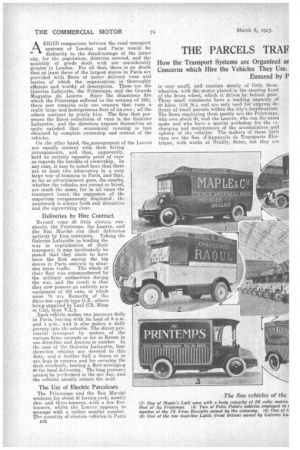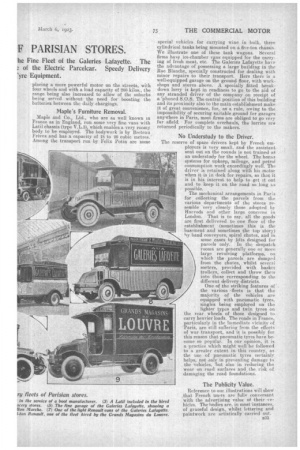THE PARCELS TRAF F PARISIAN STORES.
Page 16

Page 17

If you've noticed an error in this article please click here to report it so we can fix it.
A RIGID comparison between the road transport systemS. of London and Paris would be distinctly to the disadvantage of the latter city, for the population, districts covered, and the quantity of goods dealt with are conaiderably greater in London. For all that, there is no doubt that at least three of the largest stores in Paris are provided with fleets of motor delivery vans and lorries of which the organization is thoroughly efficient and worthy of description. These are the Galeries Lafayette, the Printemps' and the Grands Magasins du Louvre. Since the disastrous fire which the Printemps suffered in the autumn of 1921, there now remains only one concern that runs a really large and homogeneous fleet of its own ; all the others contract by yearly hire. The firm that possesses the finest collections of vans is the Galeries Lafayette, and the directors express themselves as quite satisfied that economical running is best obtained by complete ownership and control of the vehicles.
On the other hand, the,management of the Louvre are equally content with their hiring arrangements, and thus, apparently, hold an entirely opposite point of view as regards the benefits of ownership. In any case, it may be noted here that there are at least two jobm asters in a very large way of business in Paris, and that, so far as advertisement goes, the results, whether the vehicles are owned or hired, are much the same, for in all cases the transport bears the cognomen of the emporium conspicuously displayed ; the pamtwork is always fresh and attractive and the siguwriting clear.
Deliveries by Hire Contract.
Beyond 5:ome 30 little electric runabouts, the Printemps, the Louvre, and the Bon Marche run their deliveries entirely by hire contracts. Taking the Galeries Lafayette as leading the way in organization of their transport, it may incidentally be stated that they claim to have been the first among the big stores in Paris entirely to abandon horse traffic. The whole bf their fleet was commandeered by the military authorities during the war, and the result is that they now possess an entirely new equipment of 100 vans, of which some 75 are Renaults of the three-ton rapide ty_pe G.Z., others being supplied by Latil (Oh. Blinn et (le), type
Each vehicle makes two journeys daily in Paris, leaving with its load at 9 a.m. and 4 p.m., and it also makes a daily journey into the suburbs. The direct pro. vincial transport by motors of the various firms extends so far as Rouen in one direction and Amiens in another. In the case of the Galeries Lafayette, four three-ton vehicles are devoted to this duty, and a further half a dozen or so are kept in reserve and for covering the dock overhauls, leaving a fleet averaging 90 for local deliveries.The long journeys 'cannot be performed in the one day, and the vehicles usually return the next.
The Use of Electric Parcelcars.
The Printemps and the Bon March6 contract for about 50 lorries each, mostly eweand three-tonners, with a few fivetonners, whilst the Louvre appears to manage with a rather smaller number. The quantity of electric vehicles in Paris
B32 is very small, and consists mostly of little threewheelers, with the motor placed in the steering head of the front wheel, which it drives by helical gear. These small runabouts have a loading capacity of 80 kilos. (132 lb.), and are only used for express delivery of small parcels within the city's fortifications The firms employing them mostly are the Printemps, who own about 30, and the Louvre, who run the same make and who have a special workshop for the recharging and maintenance of the accumulators and upkeep of the vehicles. The makers of these little vans are the Soc. d'Appareils de Transports Electrique, with works at Neuilly, Seine, but they are placing a more powerful motor on the streets, with four wheels and with a load capacity of 200 kilos., the range being also increased to allow of the suburbs being served without the need for boosting the batteries between the daily chargings.
Maple's Furniture Removal.
Maple and Co., Ltd., who are as well known in Francs as in England, run some very fine vans with Latil chassis (type V.L.3), -which enables a very roomy body to be employed. The bodywork is by Breteau Freres and has a capacity of 18 to 20 cubic metres.' Among the transport run by Felix Potin are some
special vehicles for carrying wine in bulk, three cylindrical tanks being mounted on a five-ton chassis. We illustrate one of these tank wagons. Several firms have ice-chamber yens equipped for the carrying of fresh meat, etc. The Galeries Lafayette have the advantage of possessing a large building in the nue Blanche, specially constructed for dealing with minor repairs to their transport. Here there is a well-equipped garage on the ground floor, with workshops and stores above. A specially fitted breakdown lorry is kept in readiness to go to the aid of any stranded driver of the company on receipt of a 'phoned S.O.S. The central position of this building and its proximity also to the main establishment make it of great convenience, far, as a rule, owing to the impossibility of securing suitable ground for garages anywhere in Paris, most firms are obliged to go very far . afield. For complete overhauls, the lorries are returned periodically to the makers.
No Understudy to the Driver.
The reserve of spare drivers kept by French employers is very small, and the assistant sent out on the rounds is not trained an
an understudy for the wheel. The bonus systems for upkeep, mileage, and petrol consumption work exceedingly well. Tha driver is retained along with his motor when it is in dock for repairs, so that it is in his interest to help to get it out and to keep it on the road so long tr...s
possible. The mechanical arrangements in Paria for collecting the parcels from the various departments of the stores resemble very closely those adopted by Harrods and other large concerns in London. That is to say, all the goods are first delivered to one floor of the establishment (sometimes this is the basement and sometimes the top story) by band conveyors, spiral chutes, and in some cases by lifts designed for parcels only. In the despatch rooms are generally one or more large revolving platforms, on which the parcels are dumped from the chutes, whilst several sorters, provided with basket trolleys, 'collect and throw them into those corresponding to the different delivery districts.
One of the striking features of the various -fleets is that the majority of the vehicles are equipped with pneumatic tyres; singles being employed on the lighter types and twin tyres on the rear wheels of those designed to carry heavier loads. The roads in France, particularly in the immediate vicinity of Paris, are still suffering from the effects of war transport, and it. is possibly for this reason that pneumatic tyres have become so popular. In our opinion, it is a practice which might well be followed to a greater extent in this country,. as the use of pneumatic tyres certainly helps, not only in preventing damage to the vehicles, hut also in reducing the wear on road surfaces and the risk of damaging the road foundations.
The Publicity Value.
Reference to our illustrations will show ,that French users are fully conversant with the advertising value of their vehicles. The bodies are, in most: instances. of graceful design, whilst lettering and paintwork are artistically carried out.




























